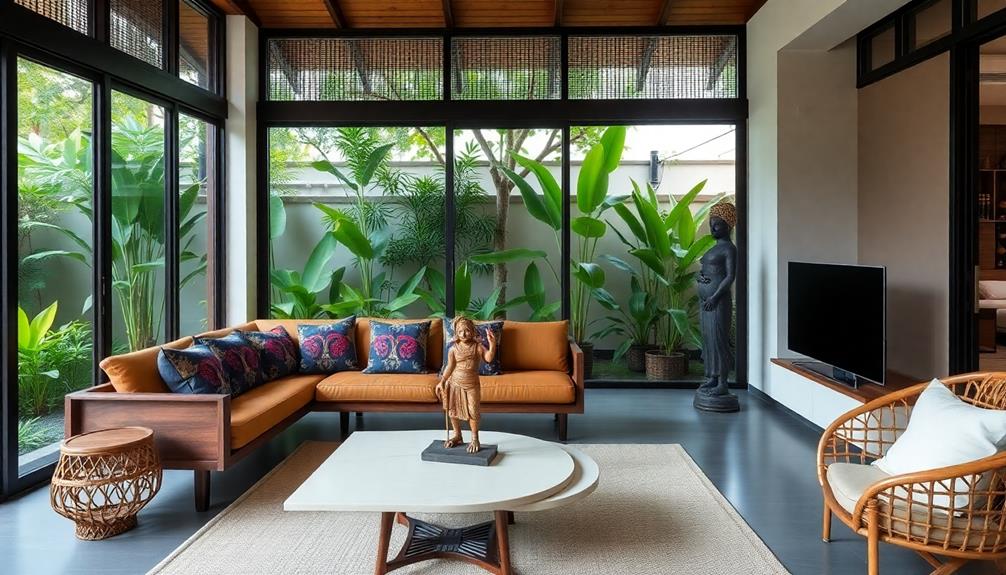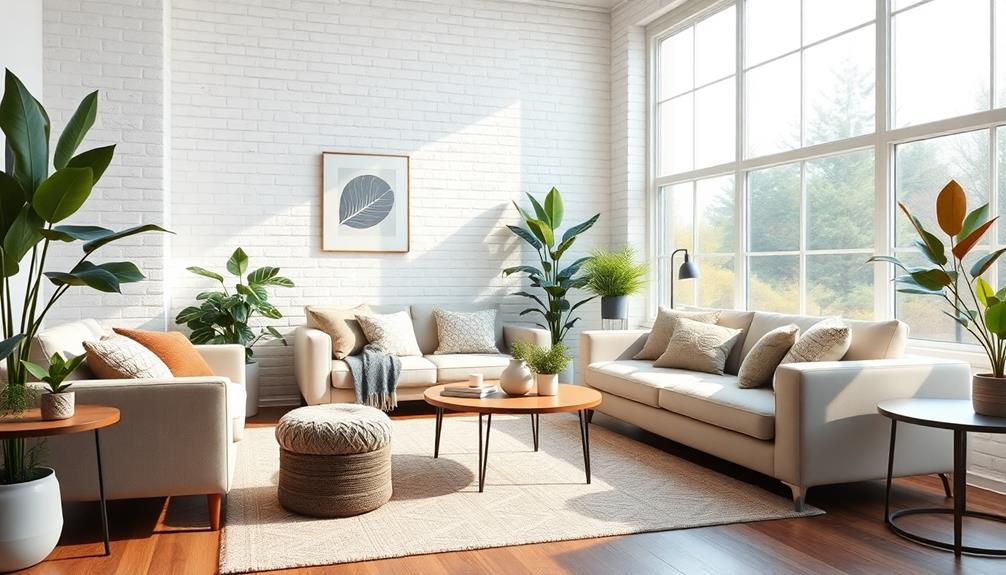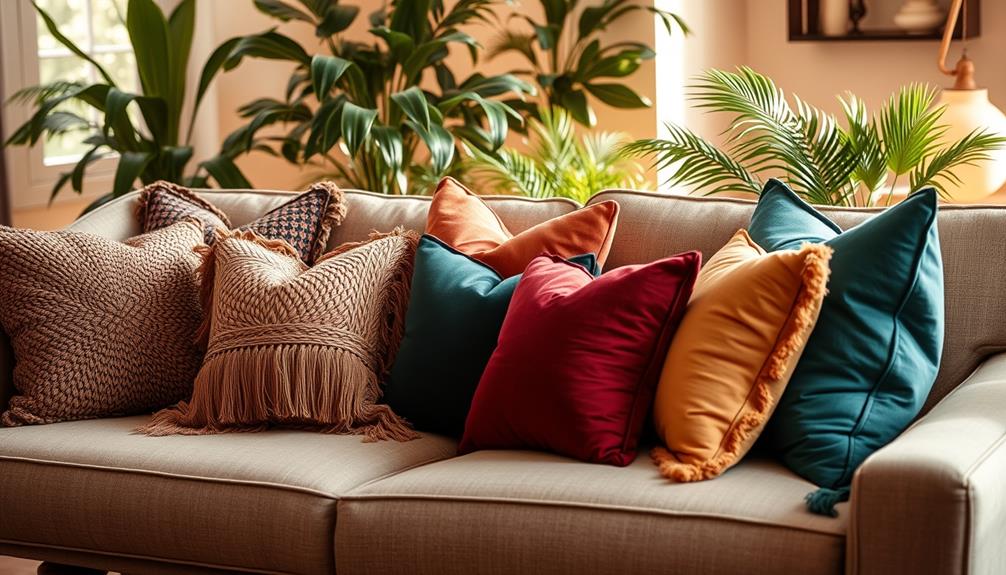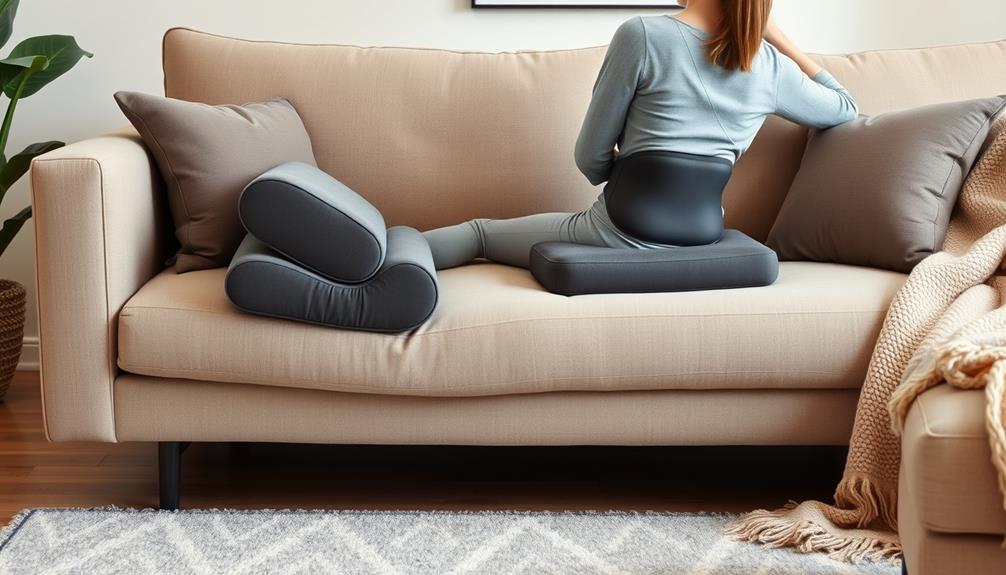Modern Balinese interior design lets you blend the rich elegance of traditional Balinese culture with sleek contemporary style. You'll find natural materials like teak and bamboo that create warmth and sustainability. The earthy color palette, accented with vibrant tones, promotes a tranquil atmosphere. Large windows and open spaces blur the lines between indoors and outdoors, inviting nature into your home. Incorporating indoor plants and water features enhances the serene vibe. Plus, you can support local artisans through handcrafted decor. Explore how to create elegant, eco-friendly spaces that reflect your unique taste and harmony with nature.
Key Takeaways
- Modern Balinese design combines traditional elements with contemporary aesthetics, utilizing natural materials like wood, stone, and bamboo for warmth and sustainability.
- Earthy color palettes with vibrant accents create a tranquil atmosphere, reflecting Balinese cultural vibrancy while promoting harmony in interior spaces.
- Open layouts and large glass doors enhance indoor-outdoor connectivity, fostering relaxation and a deeper connection with nature.
- Incorporating indoor plants and water features contributes to serenity, improves air quality, and aligns with sustainable design principles.
- Focus on craftsmanship and local materials supports artisans while blending modern amenities with eco-friendly practices for a holistic living experience.
Overview of Balinese Interior Design
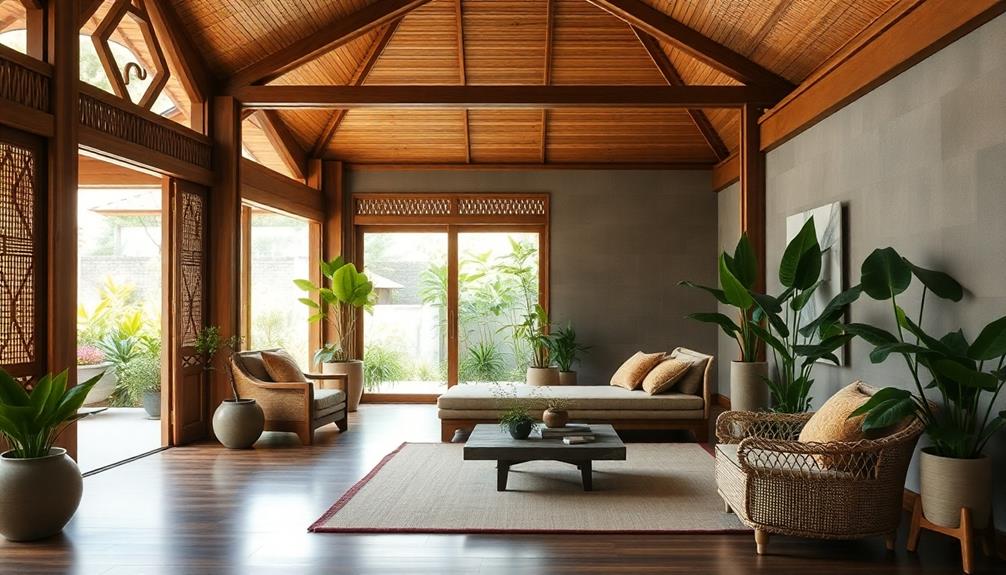
In the domain of interior design, modern Balinese style stands out for its unique blend of traditional elements and contemporary aesthetics. This design movement emerged in the early 1990s, driven by a desire to revive Balinese culture through architecture. Characterized by the use of natural materials like wood, stone, and bamboo, Balinese modern interior design harmonizes organic textures with sleek, functional furnishings. It often incorporates open spaces, lush greenery, and warm, earthy tones to create a tranquil and inviting atmosphere. This style celebrates simplicity while maintaining a deep connection to nature, reflecting the serene spirit of Bali.
You'll find that the use of natural materials like wood, stone, and bamboo creates warmth and sustainability, reflecting Bali's rich cultural heritage. The incorporation of natural materials enhances the overall aesthetic while promoting eco-friendliness and sustainability.
One of the key aspects of modern Balinese design is the emphasis on open-air layouts. These layouts blur the lines between indoor and outdoor spaces, allowing you to enjoy nature while staying comfortably inside.
Large windows and sliding doors maximize natural light and ventilation, making your living area feel more expansive.
In terms of color, the palette features earthy tones such as browns and greens, inspired by the island's landscapes. Vibrant accents add a touch of cultural vibrancy, tying the space together beautifully.
Additionally, traditional textiles, art, and handcrafted furniture are seamlessly integrated, ensuring a harmonious blend of cultural authenticity and modern design. This approach not only honors the past but also embraces contemporary aesthetics, creating a unique living environment for you to enjoy.
Key Features and Elements
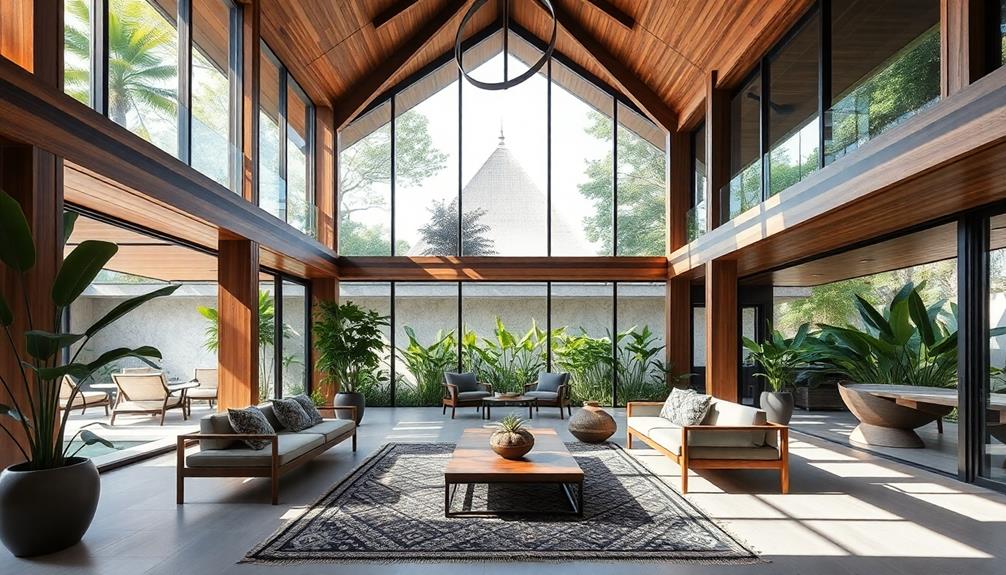
In modern Balinese interior design, you'll find a strong emphasis on natural materials like wood and stone that create a warm, inviting atmosphere.
This design style often incorporates intricate carvings and traditional textiles for added aesthetic appeal, showcasing the beauty of traditional Indonesian style decor.
The harmonious color schemes, featuring earthy tones paired with vibrant accents, help to establish a tranquil yet dynamic space.
Together, these elements reflect a deep connection to nature and cultural authenticity that defines this style.
Natural Materials Utilization
Utilizing natural materials is at the heart of modern Balinese interior design, creating spaces that feel both inviting and connected to nature. You'll find that teak wood plays a pivotal role, often used for hand-carved wooden furniture that showcases intricate designs reflecting local craftsmanship. This durable wood not only enhances the aesthetic appeal but also supports sustainable materials practices.
The incorporation of thatched roofs made from alang-alang grass adds visual charm and effective insulation against heat and rain, essential for tropical climates. Moreover, natural textures from fibers like jute and woven textiles enrich the tactile experience, grounding your space in Bali's organic environment.
| Material | Key Features | Benefits |
|---|---|---|
| Teak Wood | Durable, hand-carved | Aesthetic appeal and longevity |
| Thatched Roofs | Visual charm, insulation | Protection from elements |
| Natural Fibers | Textured, layered | Enhanced tactile experiences |
Emphasizing these elements fosters a harmonious blend of traditional and modern Balinese design, reinforcing the tranquil ambiance characteristic of the region.
Color Scheme Harmony
Embracing earthy tones like browns, beiges, and greens, modern Balinese interior design creates a tranquil atmosphere that mirrors Bali's lush environment. This color palette not only reflects nature but also promotes a sense of calmness in your living space.
To enhance visual interest, you can incorporate vibrant colors such as deep reds, yellows, and golds through accessories and artwork. These bright accents energize the room while maintaining a balanced color scheme. Additionally, you can use Indonesian decorative pillows to introduce intricate patterns and textures that elevate the overall aesthetic.
White symbolizes purity and serenity, while black adds depth and wisdom, contributing to a harmonious overall design. By weaving in traditional Balinese textiles, like batik and ikat, you'll infuse cultural authenticity into your decor. These textiles introduce vibrant patterns that complement contemporary aesthetics, enriching the overall visual experience.
Ensure that your chosen colors harmonize with natural materials like wood and stone, creating a cohesive look that feels warm and inviting.
With thoughtful consideration of your color scheme, you'll achieve a perfect blend of modern comfort and traditional elegance, making your space not just a home, but a sanctuary that embodies the essence of Bali.
Color Schemes and Atmosphere
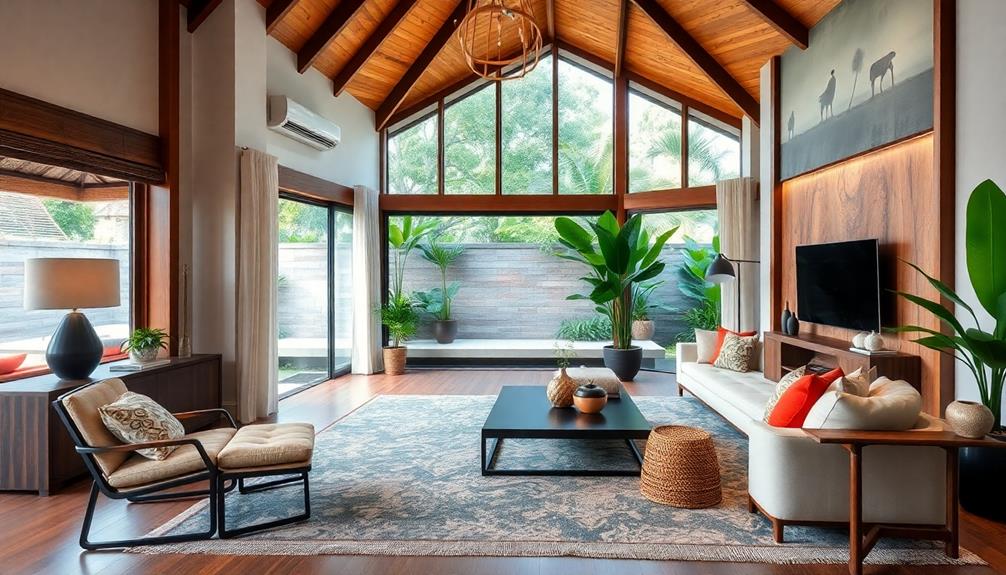
Drawing inspiration from nature, Balinese interior design showcases a harmonious color palette that fosters relaxation and tranquility.
You'll find that earthy tones, calming blues, and lush greens dominate the space, creating a serene atmosphere perfect for unwinding. The use of white symbolizes purity, while black brings wisdom, red energizes the room, yellow represents prosperity, and green connects you to nature. Incorporating traditional artistry through carefully selected decor masks can further enhance this theme, adding layers of cultural significance to your home.
Incorporating vibrant accent colors like deep reds and golds through accessories and artwork adds visual interest without overwhelming the overall aesthetic.
This blend contributes to a cohesive design that resonates with the natural materials and furnishings you choose, enhancing the cultural ambiance of your home.
Moreover, the strategic use of natural light through large windows and open spaces guarantees that your interiors feel liberating and airy.
This thoughtful approach to color schemes not only invites the beauty of the outdoors inside but also enriches your living experience. By embracing these elements, you'll create an environment that not only looks stunning but also feels peaceful and revitalizing.
Balinese design truly embodies a perfect balance of modernity and tradition, making your home a serene sanctuary.
Creating Open Spaces
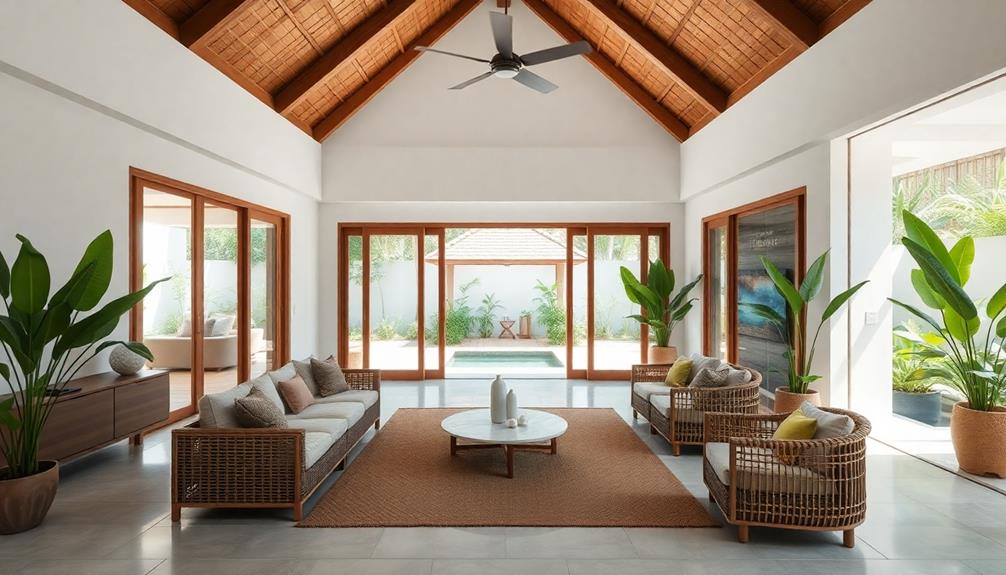
In modern Balinese interior design, creating open spaces is crucial for blending indoor and outdoor living. You'll want to emphasize large glass doors and expansive windows that blur the lines between your indoor environment and outdoor spaces. This design choice maximizes natural light and airflow, fostering an inviting atmosphere.
Open floor plans encourage movement and provide unobstructed views, enhancing the feeling of spaciousness and relaxation in your living area. Incorporating elements from expert tropical design can further enhance functionality and aesthetic appeal, ensuring that each space is tailored to your specific needs.
Incorporating courtyards and garden areas is essential, as they offer lush landscapes and water features that transform your home into a tranquil haven. Using natural materials like wood and stone for flooring and furniture deepens your connection with nature, amplifying the organic feel of your space.
Don't forget to include indoor plants to bring life and vibrancy into your home.
This seamless integration of indoor and outdoor elements not only boosts aesthetic appeal but also improves livability. By creating these open spaces, you cultivate a serene sanctuary that reflects Bali's rich cultural heritage, allowing you to experience a harmonious balance between comfort and nature every day.
Incorporating Nature-Inspired Elements
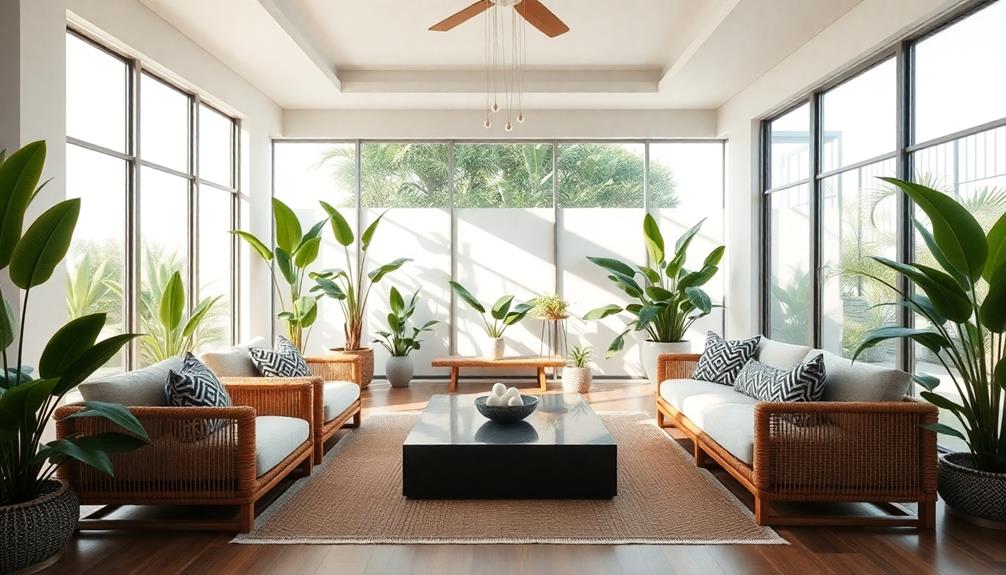
Incorporating nature-inspired elements can transform your space into a serene retreat.
Think about selecting tropical plants, integrating soothing water features, and using textured materials to enhance the overall ambiance.
Additionally, you may consider creating multifunctional spaces that promote relaxation and entertainment, as seen in tropical villa plans.
These choices not only beautify your home but also promote a deeper connection with the natural world.
Indoor Plant Selection
To create a truly inviting Balinese interior, consider selecting indoor plants that not only enhance the space but also promote a connection with nature. Incorporating tropical plants can greatly elevate your design while improving air quality.
The emphasis on modern tropical aesthetics in Bali encourages a seamless blend of indoor and outdoor environments, making the choice of plant life even more impactful. Here are some ideas for your indoor plant selection:
- Choose Tropical Plants: Incorporate palms, ferns, and orchids to reinforce that lush greenery vibe characteristic of Balinese design.
- Opt for Low-Maintenance Options: Snake plants and pothos thrive in various lighting conditions, adding greenery without requiring extensive care.
- Use Decorative Pots: Select pots made from natural materials like clay or woven rattan. This choice emphasizes organic elements and blends seamlessly with your overall design.
- Consider Vertical Gardens: If space is limited, wall-mounted planters can maximize greenery, creating a vibrant atmosphere without sacrificing floor space.
Together, these elements not only enhance your indoor environment but also contribute to a serene environment reminiscent of Bali's natural beauty.
Water Feature Integration
Water features, whether it's a tranquil pond or a soothing fountain, bring a sense of serenity and connection to nature right into your home. They enhance the aesthetic appeal of your space while promoting tranquility through the calming sound of flowing water. Integrating these elements not only beautifies your interiors but also fosters a seamless indoor-outdoor connection, allowing natural light to reflect off the water and brighten your surroundings.
By strategically positioning water features, you can embrace traditional Balinese architecture's principles, which emphasize harmony and balance. Incorporating natural materials like stone or bamboo guarantees sustainability and creates a cohesive aesthetic that resonates with the surrounding tropical landscape.
Here's a quick guide on the benefits of integrating water features:
| Water Feature Type | Benefits | Materials |
|---|---|---|
| Pond | Improves air quality | Natural stone |
| Fountain | Adds calming sound | Bamboo |
| Cascading waterfall | Enhances tranquility | Recycled materials |
| Wall fountain | Creates visual interest | Concrete |
| Reflecting pool | Promotes relaxation | Glass |
Embrace the beauty of water features to create a peaceful sanctuary in your modern Balinese-inspired home.
Textured Material Variety
Embracing a variety of textured materials can transform your modern Balinese interior into a sensory haven. By integrating natural materials, you connect your space to Bali's breathtaking landscape while promoting sustainable design.
Incorporating elements like Indonesian decor masks can also add cultural depth and storytelling to your decor. Layering different textures enhances warmth and inviting vibes, making your home feel cozy and engaging.
Here are four ideas to incorporate textured materials:
- Woven Textiles: Use jute, linen, or other natural fibers for cushions, rugs, and curtains to add softness and visual interest.
- Intricately Carved Wooden Panels: Incorporate these stunning elements as focal points or room dividers that celebrate Balinese cultural heritage.
- Volcanic Rock and River Stone: Use these materials for accent walls or outdoor spaces, adding an earthy, organic feel to your interiors.
- Tropical Plants: Infuse greenery into your design to improve air quality and enhance the theme of nature-inspired living.
Together, these textured materials create a harmonious balance in your home, inviting you to experience the beauty and essence of Bali every day.
Furniture and Layout Considerations
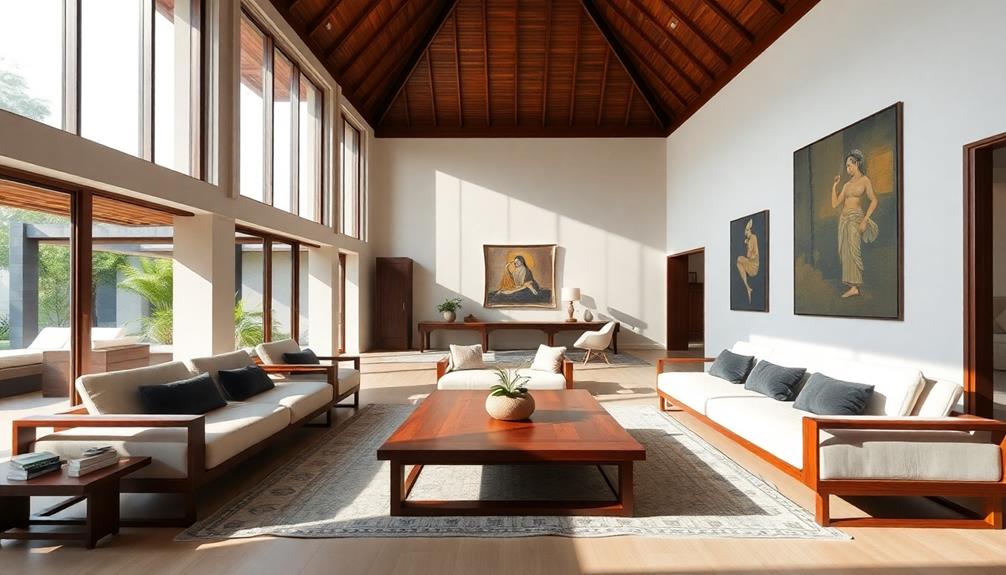
In crafting a modern Balinese interior, selecting the right furniture and layout is essential for creating a harmonious space. Start by choosing low-profile wooden furniture with clean lines that reflects the Balinese emphasis on simplicity and elegance. This not only enhances a relaxed living environment but also complements traditional Balinese homes.
Incorporating elements of traditional Indonesian housing can further enrich the design, allowing for a deeper connection to the culture.
Incorporating these elements, opt for furniture made from natural materials like rattan and bamboo to foster warmth and a connection with nature. Oversized cushions and multi-functional pieces can create versatile lounging areas, promoting comfort and adaptability in your layout.
When arranging furniture, prioritize open flow and connectivity between spaces. This design choice allows for seamless shifts between indoor and outdoor areas, enhancing your overall living experience.
You might also consider selecting decor that showcases traditional Balinese craftsmanship—think intricately carved wooden panels or sculptures—to honor cultural heritage while maintaining a modern aesthetic.
Balinese Art and Decor
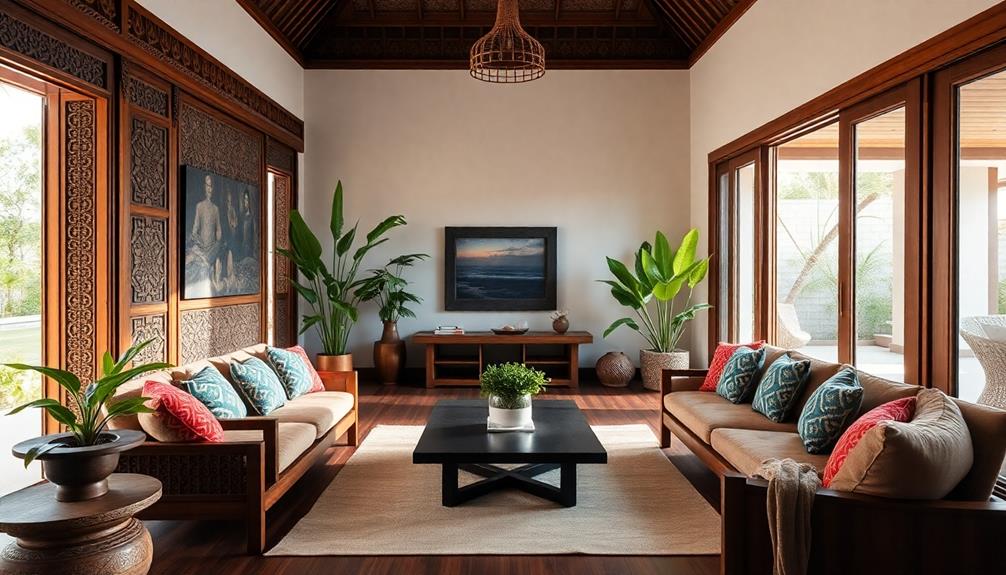
Transforming your space with Balinese art and decor infuses it with cultural richness and vibrancy. By incorporating these elements, you not only celebrate Bali's heritage but also create a harmonious environment that resonates with tradition and modernity.
Particularly, the use of Indonesian decor masks can serve as unique focal points, showcasing intricate designs that reflect the region's artistic traditions. Here are four key aspects to evaluate:
- Intricate Carvings: Adorn your walls with stunning wooden carvings that depict local myths and deities, showcasing the region's Hindu-Buddhist heritage.
- Traditional Textiles: Use batik and ikat fabrics for upholstery and decor, adding vibrant colors and patterns that reflect Bali's cultural identity.
- Handcrafted Sculptures: Incorporate beautifully crafted sculptures and masks that enhance the spiritual ambiance of your space while honoring local craftsmanship.
- Natural Elements: Integrate stone sculptures and water features to create a serene atmosphere, fostering a deep connection with nature.
Opt for sustainable materials like reclaimed wood and eco-friendly textiles to align with contemporary values.
This thoughtful approach not only beautifies your home but also contributes to environmental consciousness, merging the old with the new beautifully.
Modern Amenities and Sustainability
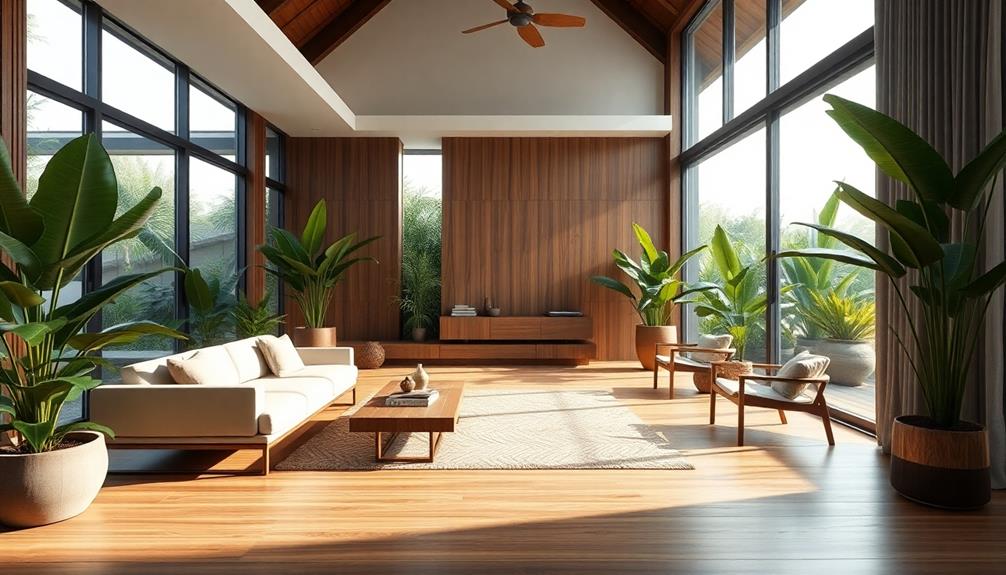
Modern Balinese interior design seamlessly merges contemporary amenities with sustainable practices, creating spaces that are both functional and eco-friendly. By integrating energy-efficient appliances and smart home technology, you can enjoy modern conveniences while minimizing your environmental impact.
| Feature | Benefits | Sustainability Aspect |
|---|---|---|
| Energy-efficient appliances | Reduced energy costs and lower carbon footprint | Eco-friendly choices |
| Natural materials | Bamboo, teak, and stone promote eco-friendly building methods | Locally sourced, reduces transport emissions |
| Maximized natural light | Decreases reliance on artificial lighting | Enhances indoor comfort and air quality |
You'll find that Balinese design emphasizes natural light and ventilation through open layouts and large windows, creating a serene living environment. Incorporating lush greenery and water features not only beautifies your space but also improves air quality. By focusing on craftsmanship and supporting local artisans, you preserve traditional techniques while promoting sustainability in home decor. This blend of modern amenities with a commitment to sustainability guarantees your living space is both stylish and responsible.
Frequently Asked Questions
What Is Balinese Style Interior Design?
Balinese style interior design combines natural materials like teak and bamboo with open spaces and soothing colors. You'll appreciate how traditional elements enhance modern aesthetics, creating a tranquil, harmonious atmosphere that promotes relaxation and connection to nature.
What Is Modern Balinese?
Imagine stepping into a serene oasis; modern Balinese combines traditional charm with contemporary flair. You'll find natural materials, open spaces, and earthy hues that invite tranquility, creating a harmonious blend of culture and modernity in your home.
What Is Modern Contemporary Interior Design?
Modern contemporary interior design combines clean lines and open spaces with a minimalist aesthetic. You'll notice neutral palettes accented by bold colors, emphasizing functionality, natural light, and a mix of textures for a dynamic environment.
What Is Traditional Contemporary Interior Design?
Imagine walking into a home that feels both timeless and fresh. Traditional contemporary interior design combines clean lines with classic materials, creating spaces that embrace comfort, functionality, and personal heritage while promoting sustainability and connection to nature.
Conclusion
Incorporating modern Balinese interior design into your home not only creates a serene atmosphere but also promotes sustainability. Did you know that homes designed with open spaces can increase natural light by up to 50%? By blending contemporary style with traditional elements, you can achieve a harmonious balance that connects your living space to nature. Embrace these principles, and you'll transform your home into a tranquil sanctuary that reflects both elegance and modern living.
